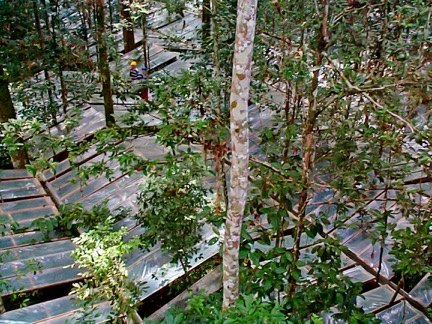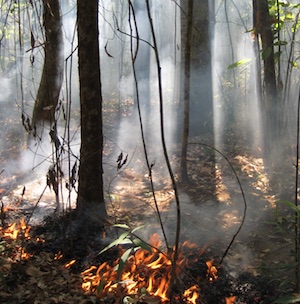Preventing an Amazon forest dieback
What is the future of the Amazon rainforest?
If current trends continue, forest fire during periods of extreme drought combined with deforestation will displace large areas of the forest with fire-prone scrub vegetation and cattle pasture. And since the forest itself generates much of the rainfall over the Amazon, continued forest loss will lead to more severe and frequent droughts, fueling a vicious downward spiral.
This is the Amazon forest dieback, an immediate and ongoing threat to the world’s largest rainforest and so also to efforts aimed at slowing global warming.
Think of it this way: with about half a trillion tons of carbon dioxide stored in Amazon trees and a pretty good chance that a tenth or more of this carbon will be released into the atmosphere over the next 20 or 30 years through deforestation and forest dieback, success in Amazon forest protection is essential to success in addressing climate change.
Can an Amazon forest dieback be avoided? After studying this question for many years, I believe the answer is “yes”—at least for a few decades, and maybe indefinitely. But doing so will depend on our ability to avoid three critical thresholds.
Three Forest Dieback Thresholds
The likelihood of a large-scale Amazon forest dieback will depend upon how much we surpass three interrelated forest thresholds; drought, fire, and the forest loss “tipping point”. Progress on any one, conversely, reduces the risk of surpassing the other two, thereby helping keep the forest – and the planet – from the brink.

Threshold #1: Drought The first threshold is the amount of annual rainfall below which adult Amazon trees begin to die, increasing forest susceptibility to fire. In the early 1990s, I began preparations to conduct an experiment to measure this threshold. Together with a large team of collaborating scientists and field technicians, we simulated a drier Amazon in a one-hectare forest plot in the Tapajos National Forest. With 6,000 plastic panels suspended above the forest floor diverting rainfall into a network of gutters and trenches, we were able to reduce the amount of rain reaching the soil by about half.
We reached the drought threshold during the third year of the experiment, in 2003. Within a few months, trees comprising one fourth of the forest’s biomass died. The ability of this forest to tolerate drought was remarkable—trees avoided the effects of the drought by absorbing moisture stored in the soil to a depth of twelve meters! This is good news for a region that will likely be subjected to more extreme drought episodes as climate change progresses.
As if to test the validity of our findings, Mother Nature unleashed a massive drought on the Amazon region two years later, drying up rivers and soils, isolating river-side communities, and killing some of the canopy trees across large swathes of the Amazon.
Threshold #2: Fire The second threshold is the severity of fire beyond which the Amazon forest is replaced by scrub vegetation.
During normal rainfall years in the Amazon, such as in 2019, healthy forests that have never been damaged by logging or previous burns simply don’t catch fire because they aren’t dry enough. The large number of fires detected in the Brazilian Amazon that year were mostly burning tracts of previously-cleared forest, weed-infested pastures and degraded forests.
Healthy forests extend like giant fire breaks across the Amazon landscape, impeding fires set deliberately by land managers to knock back weeds in pastures or clear recently-felled patches of forest. When droughts are severe, these healthy forests become vulnerable to fire, losing their firebreak function. Once ignited they can burn for weeks or months, visible from outside of the forest as long lines of smoke rising from the forest canopy.

Fires in healthy Amazon forests are not the towering infernos featured in most media coverage of Amazon fires. In fact, they seem downright innocuous–small and slow-moving. You can step over them (photo). And they are fairly easy to extinguish if small teams of trained people can reach the fire. Today, such teams exist in only a few places in the Amazon.
For my next big tree-killing experiment, I burned 50-hectare forest plots on a giant soy farm located in a forest of Mato Grosso, where there is barely enough rainfall to sustain forests and where the dry season is strong enough every year for the forest to become flammable. In 2008, I turned the leadership of this experiment over to Paulo Brando, who was the field manager and my main collaborator on the Tapajos experiment and is now an Assistant Professor at the University of California Irvine.
The experimental forest fires that we set during the first three years had only minor effects on the forest, killing roughly 5% of the adult trees each year. Then along came 2007 and a severe dry season with high temperatures and strong winds; the fires were higher and hotter that year and burned through the night instead of going out as they usually do. Half of the adult trees in the forest died after the 2007 fire. The abundant sunlight reaching the forest floor in the absence of those dead trees allowed highly-flammable and light-demanding grasses, herbs and shrubs to proliferate (photo). We had reached the threshold. Subsequent fires were far more intense because of the abundance of fine fuel. The forest became a weedy grassland with a few scattered trees, even though it had never seen a chainsaw.

Threshold #3: Forest loss and rainfall—the “tipping point” The third threshold is the area of forest loss beyond which rainfall is sufficiently inhibited that the first two thresholds are surpassed with greater frequency. This threshold is predicted by some – though not all – climate-vegetation modeling experiments that have been conducted in the Amazon.
Much of the rainfall that sustains the Amazon forest is generated by the forest itself. With each patch of forest that is lost, especially along the upwind margin of the forest in the east, the amount of evapotranspiration – water vapor produced by the forest – declines, robbing clouds of essential moisture and increasing the chance that droughts will exceed the first thresholds. We are testing where this potential threshold lies with every new increment of forest loss. There is strong evidence that rainfall is already being inhibited locally within the Amazon. The dry season has grown longer in some places with high deforestation. Forest fires, meanwhile, are more common in landscapes with high levels of forest loss. Some scientists have argued that we have already reached the “tipping point”.
Preventing the Dieback
There is a simple recipe for preventing the Amazon forest dieback: slow the loss of forest, speed its recovery where it has been cleared or damaged, and prevent and extinguish forest fires when they occur. By maximizing forest cover, especially along the upwind, eastern margin of the Amazon, we can reduce the severity of extreme, killer droughts, securing the rainfall that sustains the forest and the farming systems that Amazonian’s depend upon. By preventing forest fires, we protect forests from the second threshold.
Slow forest loss From 2004 to 2012, the annual loss of Amazon forest to chainsaws declined from 24,000 km2 to 3,500 km2 through an inter-agency strategy to enforce the law, expand the protected area network, and suspend farm credit in high-deforestation counties (Nepstad et al. 2014). The missing ingredient in this strategy was positive incentives for the farmers, businesses and rural communities that were protecting forests—it was all stick and no carrot. As we move into a new decade, the rapid growth of the voluntary carbon market represents one (though certainly not the only) way to provide these missing incentives.
Speed forest recovery A little-known secret of the Amazon forest is that it is remarkably tenacious. Cut it down and it rapidly springs back to life after all but the most extreme types of land use, such as deep tillage or poisoning with agent orange. Stumps and tree root systems send up new sprouts; seeds buried in the soil or deposited by birds, bats or ground-dwelling mammals germinate and become young trees. If protected from fire, natural forest regeneration could reclaim large areas of Amazon land that are of marginal utility for farming and livestock, with Mother Nature doing most of the work. Add this to the legal requirement farmers have to reforest their riparian zones over the next 20 years and one can easily imagine a strategy for returning one-third of the cleared lands of the Amazon—about 20 million hectares—back to rainfall-feeding, recovering forests.
Both slowing the loss and speeding the recovery of tropical forests could be an excellent target for the rapidly expanding voluntary market demand for tropical forest “offsets”—incentivizing natural forest regeneration and forest restoration, while compensating landholders who are keeping more forests on their farms than is required by law.
Prevent and control forest fires The first fires that burn healthy forests are relatively easy to put out because they are so small and slow-moving. To contain a forest fire like the one pictured above, it is sufficient to sweep a trail free of leaf litter and twigs in front of the fire line, then move or cut through downed logs and branches that could carry the fire across the fire break. Once this fire break is made, a back burn can be lit to consume the fuel that lies in the path of the fire and prevent it from jumping the break. The key challenges are to detect the forest fire before it does much damage and get to the fire with properly trained people and equipment to put it out.
Fires in healthy forests are hard to detect because they are mostly invisible to satellites. The infra-red satellite sensors that map active fires in the Amazon, for example, do not detect fires burning along the floor of healthy forests. There is simply not enough heat being released.
Instead, the best way to detect forest fires is by organizing landholders and bush pilots to report them. Whoever sees a line of smoke rising above a healthy forest should know whom to contact.
This is exactly what the non-governmental organization Aliança da Terra has done through their forest brigade—Aliança Brigada. They have extinguished dozens of forest fires within indigenous territories, on cattle ranches and on smallholder farms through a small dedicated team and through more than 600 volunteer, trained fire fighters—including many indigenous people—who can be called on to help put out fires. Aliança works closely with government fire brigades in these efforts.
A window of opportunity
Global interest in climate change solutions to slow deforestation and finance forest restoration is skyrocketing. The Amazon fires of 2019 placed the issue front and center in people’s minds, linking the protection of tropical forests directly to the broader fight to slow climate change. Corporate commitments to achieve carbon neutrality through offsets that can fund forest conservation strategies, meanwhile, continue to be made, even as jurisdictions across the tropics are actively positioning themselves to maximize the benefits of climate finance for their forests and their communities.
It will be considerably harder for humanity to prevent catastrophic climate change in the absence of an effective strategy for postponing or preventing an Amazon forest dieback. The opportunity is now to unleash the power of natural forest regeneration, to accelerate mandatory reforestation through financial incentives, to reward farmers for protecting their forests, and to organize voluntary networks of fire detectors and fighters across the Amazon to prevent and put out forest fires. It is possible to reduce the risk that the three thresholds of drought, fire, and forest loss are surpassed in a vicious downward spiral, making a large-scale Amazon forest dieback less likely, but only if we slow deforestation, speed forest recovery, and get serious about detecting and extinguishing forest fires very soon.
Note: A shorter version of this post was originally published in the Feb. 22 edition of the Straits Times.


